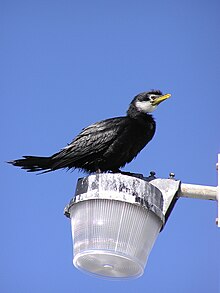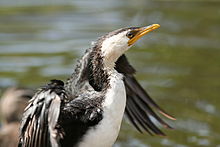Australian dwarf shark
| Australian dwarf shark | ||||||||||
|---|---|---|---|---|---|---|---|---|---|---|

Australian dwarf shag ( Microcarbo melanoleucos ) |
||||||||||
| Systematics | ||||||||||
|
||||||||||
| Scientific name | ||||||||||
| Microcarbo melanoleucos | ||||||||||
| ( Vieillot , 1817) |
The Australian dwarf shear or curly shear ( Microcarbo melanoleucos , Syn . : Phalacrocorax melanoleucos ) belongs to the family of cormorants (Phalacrocoracidae). It occurs mainly on the coasts of Australia and New Zealand and occasionally also reaches the New Zealand islands in the subantarctic.
The IUCN classifies the Australian dwarf shear as not endangered ( least concern ).
Appearance
The Australian dwarf shark reaches a body length of 55 to 65 centimeters. The wing length is 22 to 24.6 centimeters. The weight varies between 410 and 880 grams. Males tend to be slightly larger than females.
Overall, the Australian dwarf shark is a small, compactly built species of cormorant. The long tail is also characteristic of the species. Several color morphs are distinguished. The white-throated morph is black-gray with a greenish sheen on the upper side of the body. The top of the head, the back of the neck and the sides of the neck as well as the lower front neck are black. In contrast, the face up to the eyes and the front neck are white. The rest of the underside of the body is blackish. The so-called magpie-colored morph, on the other hand, is also white on the underside of the body. The beak is short and strong and varies in color between yellowish, greenish or brownish.
Australian dwarf shags can be seen both on the coast and in inland waters and also use smaller bodies of water and rivers to forage. They rest and nest in trees and bushes near the water and also grow on fence posts, on the masts of boats and on telephone lines. Your walk ashore is waddling. They can be observed relatively often individually. Australian dwarf shags can fly up at an angle of 45 degrees, which is about twice as steep as other Australasian cormorants.
The Australian dwarf shark is relatively easy to identify by its short yellow beak and wedge-shaped tail. There are possibilities of confusion within the distribution area with the magpie and the black-faced cochin . However, both species are significantly larger and have a longer beak. The featherless facial skin is also black in the black face scar.
Distribution area and habitat
The Australian dwarf shag occurs from Indonesia to New Guinea to the Solomon Islands, Australia and New Zealand. Stray visitors occasionally reach Lord Howe Island , Norfolk Island and Campbell Island .
Their habitat are both protected coastal sections and inland waters. It uses a wide range of different natural and artificial bodies of water, including swamps, backwater, billabongs , canals, ponds, cattle troughs and ornamental ponds. Their preferred habitat are open freshwater lakes and permanent or temporary floodplains. On the coast, the Australian dwarf shag can be found in bays, estuaries and ports. It is also found in salt pans and mangrove swamps. On the other hand, it rarely occurs on stretches of coast that are exposed to unprotected wind.
The range of the Australian dwarf shark has increased in both Australia and New Zealand. It occurs where wooded regions have been cut down and water reservoirs built. The population has declined overall, however, because the wetlands that have remained and that have been created offer less living space than they had before European colonization.
The behavior of the young birds is predominantly dismigratory . Ringed young birds were mostly found up to 125 kilometers from the nesting site two months after being ringed. After six months, they are in a region that is an average of 300 kilometers from the place of birth. However, some of them return to their place of birth. In general, the dismigration is more pronounced in young birds that grow up in breeding colonies inland than in those that grow up in breeding colonies near the coast.
nutrition
The diet of the Australian pygmy shark consists of small fish. In the north of Australia, it also eats large quantities of introduced species of fish such as carp and perch .
The food is caught diving. The Australian dwarf shark spends an average of 16 seconds underwater. The break between the individual dives is very short and averages 7 seconds. She eats small prey under water, while larger ones are brought to the surface of the water and eaten there. If fish are too big and cannot be swallowed all at once, they are brought to the water's edge. Crustacean claws are removed by shaking movements before they are swallowed by the claw.
Australian pygmy shags usually look for food individually, but they have also been seen hunting together. These hunting parties numbered up to 200 individuals. The formation of such troops is possibly due to an abundance of food. It often happens that Australian dwarf shags look for food in the vicinity of groups of black sharks , and resting Australian dwarf shags are also often associated with this species of cormorant.
Reproduction
The Australian pygmy punt uses a number of very different bodies of water for its reproduction. Nesting trees are found on the banks of lakes, billabongs, rivers, and in swamps. Occasionally, the Australian pygmy shag breed with other species of cormorants on islands off the coast. Breeding colonies can range from 5 to more than 1000 nests. However, the dwarf shags occasionally also breed individually. Most breeding colonies consist of fewer than 100 nests. Other species of cormorants such as herons, spoonbills, darter and ibises often breed in their colonies. The oviposition within the large colony is not synchronized in contrast to sub-colonies within such colonies.
Australian dwarf shags enter into a monogamous couple relationship that can last for more than one breeding season. The previous studies on the breeding season have not produced a uniform result: it is mainly in the period October to November, observations are also available from South Australia that refer to the month of May, and from the Australian state of Victoria it has been proven that these birds also breed in August . Australian dwarf shags are likely not tied to a specific breeding season and can reproduce throughout the year if habitat conditions allow.
The nest is built on branches or in forks of trees of eucalyptus, mangroves, casuarines or myrtle heaths . The nesting trees are usually at the edge of the water and the nests are on average 2.8 meters above the surface of the water.
The clutch size has not yet been conclusively investigated; it is probably three to five eggs. The eggs are elliptical and rough. Their shells are pale bluish and have white lime spots. The incubation period is not known. Newly hatched nestlings are initially naked and have black skin and there is a red spot on the throat. After a few days they are covered by black dunes. As soon as the first signs of age appear, they rush out of the nest in the event of disturbances and submerge in the water. How long the young birds stay in the nest and how the male and female parent birds participate in the rearing is not known.
So far, there are only a few studies on the breeding success. In one breeding colony, 14 chicks were observed to hatch from 24 eggs; in two more carefully observed nests, 7 chicks hatched from 8 eggs, of which 6 fledged. The predators include crows and the wedge-tailed harrier .
literature
- PJ Higgins (Ed.): Handbook of Australian, New Zealand & Antarctic Birds , Volume 1, Ratites to Ducks, Oxford University Press, Oxford 1990, ISBN 0195530683
- Hadoram Shirihai: A Complete Guide to Antarctic Wildlife - The Birds and Marine Mammals of the Antarctic Continent and Southern Ocean , Alula Press, Degerby 2002, ISBN 951-98947-0-5
Web links
- Videos, photos and sound recordings of Phalacrocorax melanoleucos in the Internet Bird Collection
- Microcarbo melanoleucos inthe IUCN 2013 Red List of Threatened Species . Listed by: BirdLife International, 2012. Retrieved February 2, 2014.




